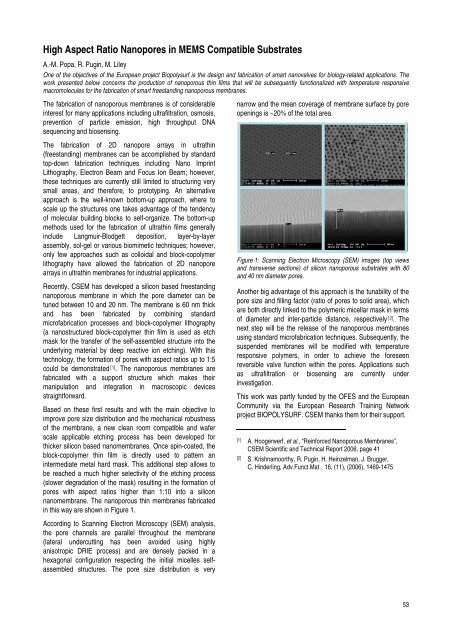research activities in 2007 - CSEM
research activities in 2007 - CSEM
research activities in 2007 - CSEM
You also want an ePaper? Increase the reach of your titles
YUMPU automatically turns print PDFs into web optimized ePapers that Google loves.
High Aspect Ratio Nanopores <strong>in</strong> MEMS Compatible Substrates<br />
A.-M. Popa, R. Pug<strong>in</strong>, M. Liley<br />
One of the objectives of the European project Biopolysurf is the design and fabrication of smart nanovalves for biology-related applications. The<br />
work presented below concerns the production of nanoporous th<strong>in</strong> films that will be subsequently functionalized with temperature responsive<br />
macromolecules for the fabrication of smart freestand<strong>in</strong>g nanoporous membranes.<br />
The fabrication of nanoporous membranes is of considerable<br />
<strong>in</strong>terest for many applications <strong>in</strong>clud<strong>in</strong>g ultrafiltration, osmosis,<br />
prevention of particle emission, high throughput DNA<br />
sequenc<strong>in</strong>g and biosens<strong>in</strong>g.<br />
The fabrication of 2D nanopore arrays <strong>in</strong> ultrath<strong>in</strong><br />
(freestand<strong>in</strong>g) membranes can be accomplished by standard<br />
top-down fabrication techniques <strong>in</strong>clud<strong>in</strong>g Nano Impr<strong>in</strong>t<br />
Lithography, Electron Beam and Focus Ion Beam; however,<br />
these techniques are currently still limited to structur<strong>in</strong>g very<br />
small areas, and therefore, to prototyp<strong>in</strong>g. An alternative<br />
approach is the well-known bottom-up approach, where to<br />
scale up the structures one takes advantage of the tendency<br />
of molecular build<strong>in</strong>g blocks to self-organize. The bottom-up<br />
methods used for the fabrication of ultrath<strong>in</strong> films generally<br />
<strong>in</strong>clude Langmuir-Blodgett deposition, layer-by-layer<br />
assembly, sol-gel or various biomimetic techniques; however,<br />
only few approaches such as colloidal and block-copolymer<br />
lithography have allowed the fabrication of 2D nanopore<br />
arrays <strong>in</strong> ultrath<strong>in</strong> membranes for <strong>in</strong>dustrial applications.<br />
Recently, <strong>CSEM</strong> has developed a silicon based freestand<strong>in</strong>g<br />
nanoporous membrane <strong>in</strong> which the pore diameter can be<br />
tuned between 10 and 20 nm. The membrane is 60 nm thick<br />
and has been fabricated by comb<strong>in</strong><strong>in</strong>g standard<br />
microfabrication processes and block-copolymer lithography<br />
(a nanostructured block-copolymer th<strong>in</strong> film is used as etch<br />
mask for the transfer of the self-assembled structure <strong>in</strong>to the<br />
underly<strong>in</strong>g material by deep reactive ion etch<strong>in</strong>g). With this<br />
technology, the formation of pores with aspect ratios up to 1:5<br />
could be demonstrated [1] . The nanoporous membranes are<br />
fabricated with a support structure which makes their<br />
manipulation and <strong>in</strong>tegration <strong>in</strong> macroscopic devices<br />
straightforward.<br />
Based on these first results and with the ma<strong>in</strong> objective to<br />
improve pore size distribution and the mechanical robustness<br />
of the membrane, a new clean room compatible and wafer<br />
scale applicable etch<strong>in</strong>g process has been developed for<br />
thicker silicon based nanomembranes. Once sp<strong>in</strong>-coated, the<br />
block-copolymer th<strong>in</strong> film is directly used to pattern an<br />
<strong>in</strong>termediate metal hard mask. This additional step allows to<br />
be reached a much higher selectivity of the etch<strong>in</strong>g process<br />
(slower degradation of the mask) result<strong>in</strong>g <strong>in</strong> the formation of<br />
pores with aspect ratios higher than 1:10 <strong>in</strong>to a silicon<br />
nanomembrane. The nanoporous th<strong>in</strong> membranes fabricated<br />
<strong>in</strong> this way are shown <strong>in</strong> Figure 1.<br />
Accord<strong>in</strong>g to Scann<strong>in</strong>g Electron Microscopy (SEM) analysis,<br />
the pore channels are parallel throughout the membrane<br />
(lateral undercutt<strong>in</strong>g has been avoided us<strong>in</strong>g highly<br />
anisotropic DRIE process) and are densely packed <strong>in</strong> a<br />
hexagonal configuration respect<strong>in</strong>g the <strong>in</strong>itial micelles selfassembled<br />
structures. The pore size distribution is very<br />
narrow and the mean coverage of membrane surface by pore<br />
open<strong>in</strong>gs is ~20% of the total area.<br />
Figure 1: Scann<strong>in</strong>g Electron Microscopy (SEM) images (top views<br />
and transverse sections) of silicon nanoporous substrates with 80<br />
and 40 nm diameter pores.<br />
Another big advantage of this approach is the tunability of the<br />
pore size and fill<strong>in</strong>g factor (ratio of pores to solid area), which<br />
are both directly l<strong>in</strong>ked to the polymeric micellar mask <strong>in</strong> terms<br />
of diameter and <strong>in</strong>ter-particle distance, respectively [2] . The<br />
next step will be the release of the nanoporous membranes<br />
us<strong>in</strong>g standard microfabrication techniques. Subsequently, the<br />
suspended membranes will be modified with temperature<br />
responsive polymers, <strong>in</strong> order to achieve the foreseen<br />
reversible valve function with<strong>in</strong> the pores. Applications such<br />
as ultrafiltration or biosens<strong>in</strong>g are currently under<br />
<strong>in</strong>vestigation.<br />
This work was partly funded by the OFES and the European<br />
Community via the European Research Tra<strong>in</strong><strong>in</strong>g Network<br />
project BIOPOLYSURF. <strong>CSEM</strong> thanks them for their support.<br />
[1] A. Hoogerwerf, et al., “Re<strong>in</strong>forced Nanoporous Membranes”,<br />
<strong>CSEM</strong> Scientific and Technical Report 2006, page 41<br />
[2] S. Krishnamoorthy, R. Pug<strong>in</strong>, H. He<strong>in</strong>zelman, J. Brugger,<br />
C. H<strong>in</strong>derl<strong>in</strong>g, Adv.Funct.Mat., 16, (11), (2006), 1469-1475<br />
53








